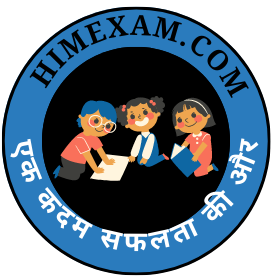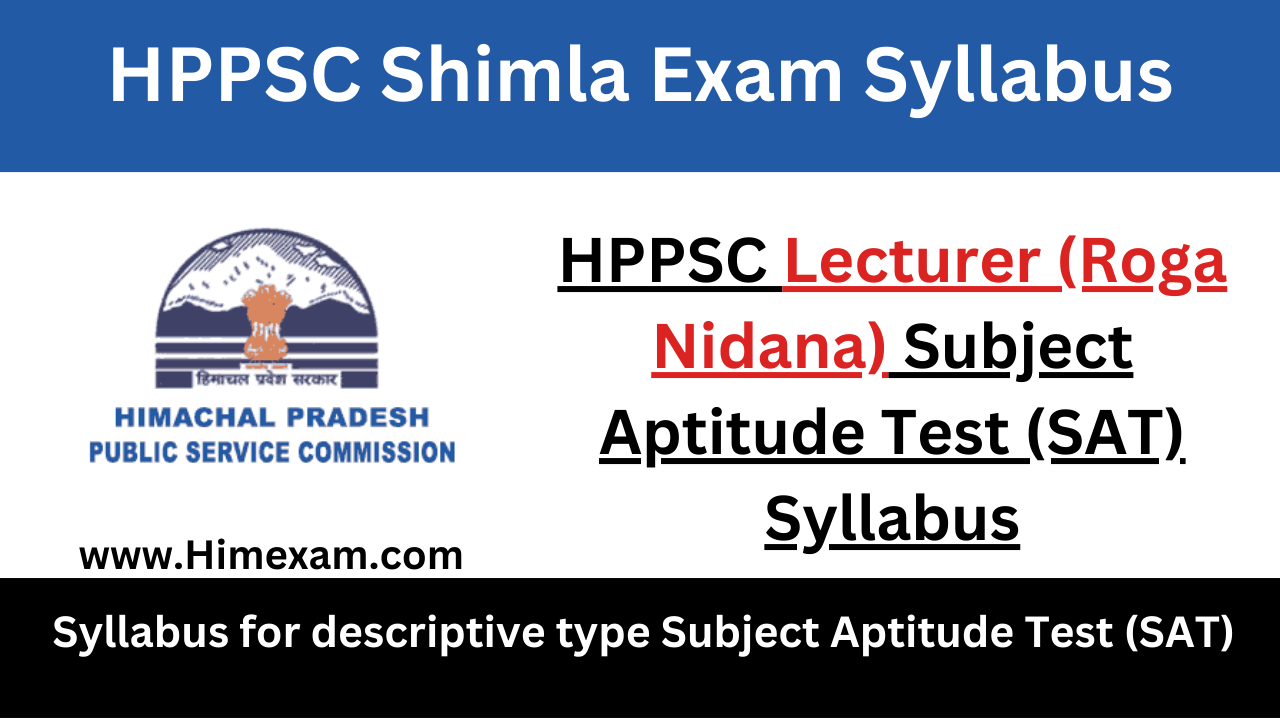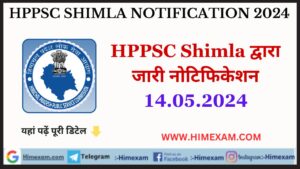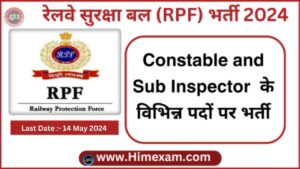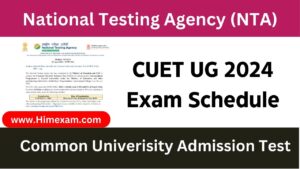HPPSC Lecturer (Roga Nidana) Subject Aptitude Test (SAT) Syllabus
HPPSC Lecturer (Roga Nidana) Subject Aptitude Test (SAT) Syllabus:-Syllabus for descriptive type Subject Aptitude Test (SAT) for the recruitment to post of Lecturer (Roga Nidana) Class-I (Gazetted) in the AYUSH Vibhag, H.P. The descriptive SAT paper shall have two parts, i.e. Part-I and Part-II of 03 hours duration having 120 Marks.
HPPSC Lecturer (Roga Nidana) Subject Aptitude Test (SAT) Syllabus
PART-I (60 MARKS)
1. Fundamental principles of Roganidana:- Concept of Tridosha and its Pathological implications, 63 permutations and combination of Tridosha, Lina and Stambhita Dosha, their cause and importance in manifestation of Samprapti, Concept of Rakta as a Chaturtha Dosha, Importance of Rakta in the manifestation of diseases, Concept of Ashrayashrayi bhava and its applied utility, Different types of Dosha Gati, Causative factors and practical utility of movement of Doshas from Kostha to Shakha and Shakha to Koshtha, Concept of Ashayapakarsha, Trayorogamarga, their diseases and clinical importance of RogaMarga, Concept and classification of Avarana, its role in pathogenesis, mode of diagnosis of Avarana and its importance in chikitsa sutra, Applied aspect of Dhatu Poshana Krama and Dhatu Samvahana, Concept of Margaga and Sthanastha Dhatus, Concept and applied aspects of Doshapaka and Dhatupaka, fundamental and applied aspect of Datu, Upadhatu and Mala, Diseases developed due to their vitiation(pradoshajavikara).
2. Concept and applied aspects of Srotas, their importance in health and diseased conditions, Concept and applied aspects of SrotoDushti and Khavaigunya, Understanding the various srotas which are not included in classical list of srotas but enumerated while describing the samprapti of disease, Description of Dosha-Dushya-Samurchhana, Concept of Prakriti Sama Samaveta and VikritiVishamaSamavetaSammurchhana, Importance of Dosha-DushyaSammurchhana in diagnosis and treatment, Concept of Vikaravighatabaavabhavaprativisesha, Concept of Agni and its role in manifestation of health and disease, Concept and pathogensis of Ama, Contemporary interpretation of Ama and its role in pathogenesis, Sama, Nirama stages of Dosha, Dahtu and Mala, Understanding Samprapti of Santarpanottha and ApatarpanotthaVyadhi, Detailed classification of disease as described in Ayurveda, Knowledge of ICD and DSM classification, Detailed understanding of NidanPanchaka with their classification and clinical importance, Relation between ‘Hetu&Lakshana’and ‘Samprapti&Lakshna’, Explanation and applied aspects of Kriyakala and its utility in diagnosis and treatment, Importance of Upadrava, Arishta and Sadhyasadhyata and Udarka, Natural history of the diseases, concept of Vyadhisankara in Ayurveda.
3. RogaVigyana:- Knowledge of classical Samprati of following diseases with interpretation of NidanaPanchaka including Upadrava, Arishta and Sadhyasadhyata and Chikitsa Sutra, Knowledge of commonly occurring diseases of the respective systems, mentioned in contemporary medicine and their Ayurvedic interpretation, Diseases ofPranavahasrotas-KasaShwasa-Hikka-Urahkshata-Shosha-Rajayakshma and Ayurvedic understanding of common clinical entities like Pneumonia, Pleural effusion, Bronchitis, Bronchiectasis, Pulmonary Tuberculosis, Bronchial Asthma; Diseases of Annavaha-PureeshavahaSrotas- AgnimandyaAjirna-Aruchi-Chhardi, Amlapitta- Shoola, Grahani-Gulma-Udara Roga-Vibandha, AtisaraPravahika along with various clinical presentation, Ayurvedic understanding of common, clinical entities like Peptic Ulcer, Irritable Bowel Syndrome, Diarrhoea, Dysentery, Constipation, Ulceration colitis; Diseases of UdakavahaSrotas- Trishna, Daha and knowledge of water and electrolyte imbalance disorders; Diseases of RasavahaSrotas- Jwara and Ayurvedic understanding of common clinical entities like various type of Fever- Malaria, Typhoid, Viral fevers, Pandu, Amavata, Hridroga, Shotha and Ayurvedic understanding of common clinical entities like Anaemia & its classification, Rheumatic fever, Rheumatoid Arthritis, Angina, Ischaemic Heart Disease, Hypertension, Myocardial Infarction, Congestive cardiac failure.
4. Diseases of RaktavahaSrotas- Kamala- Raktapitta- Vatarakta-kroshtukaseersha-ShitapittaMahaKushta-Visarpa-Shwitra and KhudraKushta and Ayurvedic understanding of common clinical entities like jaundice, hepatitis, bleeding disorders, Gout, ThromboAngitisObliterens (TAO), Deep Vein Thrombosis (DVT) Leukaemia, Thalessemia, Sickle Cell Anaemia, Introduction to Urticaria, Psoriasis, Eczema, Pemphigus, Herpes; Diseases of Mamsavahasrotas- Introduction to Granthi, Arbuda, Galaganda and Arsha, Ayurvedic understanding of all types neoplasia and Thyroid diseases; Diseases of MedovahasrotasSthoulya-Karshya-Prameha and Ayurvedic understanding of common clinical entities like Obesity and Diabetes Mellitus; Disease of Asthi- Majjavahasrotas-Sandhigatavata, introduction to Asthi-majjaparipaka, AsthigataVidradhi and Ayurvedic understanding of common clinical entities like Osteo-Arthritis, Osteomyelitis, Osteoporosis.
5. Vatavyadhi- Akshepaka –Apatanaka –Ardita –Pakshaghata –Gridhrasi -Viswachi, Avabahuka, Manyasthambha-Katigraha-Pangutwa-Khanja-Khalwee and Ayurvedic understanding of common clinical entities like Hemiplagia, Parkinson’s disease, Lumbago-Sciatica syndrome, Bell’s Palsy, Ankylosing Spondylitis, MND and other commonly occurring neurological diseases, Diseases of SukravahaSrotas-Klaibya and Vandhyatva and understanding of male 3 and female infertility, impotence; Diseases of Mutravahasrotas-Mutrakrichha-Mutraghata, Ashmari and Ayurvedic understanding of common clinical entities like Urinary Tract Infection, Urolithiasis, Nephropathies and Renal Failure; Diseasesof Swedavahasrotasknowledge of khalitya, Palitya and Cosmetology; Diseases of ManovahaSrotas- Vishada, Udvega,Bhaya, Bhrama, Anidra, Mada, Murchha, Sanyasa, Apasmara, Unmada, Atatwabhinivesha and Ayurvedic understanding ofcommon clinical entities like Depression, Anxiety, Neurosis, Phobia, personality disorders, IndriyaPradoshajaVikara, JaraJanyaVyadhi; Alzheimer’s disease, Concept and tools for the study of AnuktaVyadhi (unexplained and newly emerging diseases), Understanding the concept of karmajavyadhi.
PART-II (60 MARKS)
1. ParikshaVigyana:- Introduction to Clinical methods and technique for the study of clinical examination, Importance of medical history taking and its importance in clinical medicine, Aims, objectives and methods, applied aspects and importance of various Rogi and RogaPariksha as per classics, SrotasPariksha, ShadangaPariksha vis-à-vis general and systemic examination of patient, Interpretation of Charakoktatrividhapramanapariksha and Sushrutoktashadavidhapariksha with clinical methods mentioned in modern medicine, Interpretation and use of ashtasthananirikshana along with use of current tools as per Ayurveda.
2. Charakoktadashavidha and SushrutoktaDwadashavidhapariksha along with the use of modern supportive tools for understanding of rogibala and rogabala concept to derive chikitsa sutra, Ayurvedic interpretation of all relevant findings of modern clinical examinations, various Laboratory and other diagnostic tools, Understanding of diagnostic procedures in medical emergencies, Concept of Good clinical practice in Ayurveda and modern medicine.
3. Knowledge of standard clinical laboratory set up useful for Ayurvedic practice, Knowledge of Ancillary common laboratory investigations for diagnosis of diseases, their methods, normal and abnormal values, factors influencing values and their Ayurvedic interpretations & clinical significance, Importance of Bio markers and their utility in clinical researches, Update knowledge of emerging diagnostic tools and technologies, Knowledge of various Ayurvedic diagnostic software’s /programs available, AvayavaPariksha-Radio-imaging Techniques, Sonological Techniques, ECG, EEG, etc and their clinical interpretation.
4. VikritiVigyana and JivanuVigyana:- Introduction to pathology and technique for the study of pathology, cell injury and cellular adaptations, Immuno-pathology including amyloidosis and its interpretation with the concept of Ojas vis-à-vis Bala, Concept of Shotha versus inflammation, oedema and healing, Derangement of Homeostasis and Hemodynamic disorders, General character and classification of Neoplasia.
5. UpasargajanyaVyadhi (Communicable diseases)- Romantika-Masurika-Upadamsha-Phirang and introduction to Syphilis, AIDS, Leprosy, Tuberculosis, Detail study of KrimiVigyanam versus infectious and parasitic diseases along with their mode of infection and life cycle, Concept of Snayuka, Shleepada and introduction to Filariasis and classification of common parasites, Concept and applied aspects of Janapadodhvamsa and Environmental diseases, Nutritional disorders, Concept of genetic diseases and its interpretation in terms of Bija Dosha, Knowledge of common Bacteria, Virus, Parasites, Fungi and their classification with their disease processes, nutrition requirements, media and methods for culture and sensitivity.
| CLICK HERE |
More Pages:-
हेलो दोस्तों ,आपका हमारी वेबसाइट Himexam.com पर स्वागत है। जैसा की आपको पता है हमारी वेबसाइट Himexam.com आपको समय-समय पर सभी HP Govt Jobs & All India Govt Jobs की Notifications प्रदान करवाती है। साथ ही साथ Himachal Pradesh Exam Previous Paper और Himachal Pradesh GK ,Himachal Pradesh & National +International Current Affairs के सभी नोट्स मुफ्त उपलब्ध करवाते है। हमारी वेबसाइट के अलग अलग प्लेटफार्म पर pages & Group बने है जैसे की facebook ,Telegram और Instagram .. अगर आप हिमाचल के किसी भी पेपर की तैयारी कर रहे हो तो जल्दी से इन groups के साथ जुड़ जाएं इनके लिंक नीचे table में दिए गए है।
Join Us:-
| Like Our Facebook Page | Click here |
| Join Us oN Telegram | Click here |
| Join Us On Instagram | Click Here |
